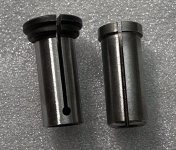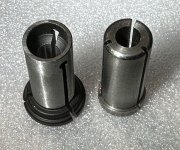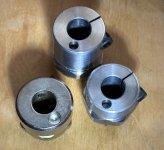The MuscleChuck manufacturer, De Rosa, is still active. You can write and get answers via email, but apparently just one answer per email. And you can buy stuff.
I bought a kit that includes the #1E chuck (extended length for PC 7518), one of his 1/4” collets, and a T-handle hex wrench. Took a few days via USPS to get to NYC.
The extended chuck adds .42” to the length of the regular MuscleChuck. That’s a little more than a thick wrench worth but it will help. I use the DustMaster/MilesCraft dust collection kit that uses a silicon collar around the collet so I loose about a 1/4” in height when lifting the router. The MC E will replace that and more but even the regular length MC is easy enough to access in a lift in a router table.
My MC #1 has an id of .4999. I can’t get my .5000 precision dowel pin into it. My MC #1 E is slightly tighter. I think the clamp portion has been over tightened so the “loose” end is slightly inside of being concentric. Most of the bits I’ve measured (both 1/2 and 1/4 inch) are at least .0005” under their nominal shank diameter so fit really well in the MC. Once started in the MC a heavy bit slowly slides down as the air escapes.
I wrote previously about how difficult it was to get a 1/4” bit tight in the MC using a Whiteside 1/4” collet adapter. The Whiteside 1/4” collet is .002” under in the od and it’s a little large in the id. The MuscleChuck 1/4” collet works great. It’s a better design and better made. It costs twice as much but is probably the only collet that works well with the MC. It’s suitable for any kind of collet. It even has an oversized top that is undercut so you can grab the collet to pull it out.
I also bought an Eliminator chuck via ebay and I’m not sure what version it is. At the Eliminator website there are two patent numbers mentioned, one for the first gen and one for the current version. This chuck’s packaging has a different patent number but it still uses a screw driven wedge that pushes the bit against the opposite wall of the chuck. Even though the Whiteside collet reducer is undersized the Eliminator wedge can close it tightly against a 1/4” bit easily if the full length slot is positioned in the right place.
However, the Eliminator chuck is .5001” id so when the wedge is tightened it pushes a .4995 shank against the opposite side of the rigid collet leaving the bit .0006 off center. And there are only two points of contact between the bit and the collet. Using 1/4” bit in the Whiteside adapter put the bit even farther off-center. In the MC the 1/2” bit will be .0004” off but there is more contact with the kind of clamp used by the MC. I don’t know if there is any practical difference but in principle I’d try to limit how much time the router runs with a big bit installed in one of these chucks.




